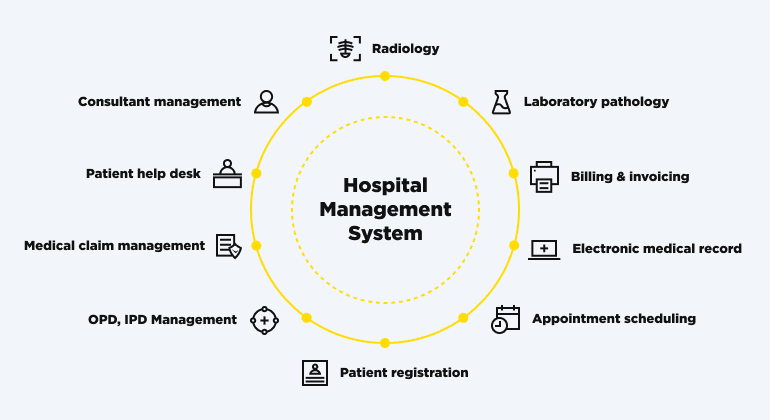Healthcare is a well-funded industry that is first on the line to adopt new technological innovations. You would ask why? Because the stakes are higher than anywhere else. The healthcare business’s main focus is human life and patient experience.
It seems fitting that VR and AR tools made their way to the medical care industry, revolutionizing many aspects of it. ​Augmented reality apps for healthcare provide solutions to the most significant challenges and pain points for medical professionals. The innovative applications of virtual and augmented reality technology in the healthcare field are vast, from improving medical training and education to enabling remote rehabilitation and assisting during surgery.
Read on to explore ways in which virtual and augmented reality is transforming healthcare and what the future holds for this out-of-this-world technology.
Augmented and Virtual Reality in the Healthcare Sector: Market Overview
The global pandemic in 2020 spiked the digitalization of the healthcare industry. The estimated value of the worldwide healthcare VR market was $336.9 million by the end of 2020. Moreover, Goldman Sachs Global Investment Research stated that healthcare is one of the top 3 industries that will remain leaders in implementing VR and AR technology up to 2025.
Want to know an even longer forecast period? ResearchAndMarkets released that the global AR market will generate $152 billion by 2030 at a CAGR of 36%, while the healthcare Augmented Reality market will register a CAGR of 26% during 2022-2027.
With experts forecasting significant growth in the market of AR and VR in healthcare, it’s clear that this technology is bound to play a vital role in the future of healthcare services.
Difference Between Augmented Reality and Virtual Reality for Healthcare
AR and VR in healthcare are like tech superheroes. Both of them bring something unique to the table and are real game-changers. However, there are some significant differences between them as they serve different purposes and solve various problems. Let’s discover more.
Virtual reality creates an entirely digital environment, taking users to a simulated world where they can train, diagnose illnesses, and practice surgeries without worrying about the real world. Just imagine medical students carrying out intricate procedures without posing any threat to real patients and having the flexibility and opportunity to actually learn (sometimes on their own mistakes). They get a chance to improve their skills, get data-driven insights, and gain confidence from this intense training. Moreover, VR technology can also be a lifesaver for patients. The thing is that they provide therapeutic environments that aid in chronic pain management or mental health issues by offering relaxation and distraction.
On the other hand, AR is able to enhance our surroundings by adding a digital layer to the real world. How does it work? For example, during an operation, a surgeon wearing AR glasses can view a patient's vital signs and even a 3D model of their organs. In other words, AR technology advances reality, extending doctor’s possibilities due to this. This real-time improved data leads to increased accuracy and better patient outcomes as a result. What is more, AR is beneficial for remote help, as it allows experts to mentor physicians through complicated procedures from a distance (top-rated and practical solutions since the pandemic).
Overall, VR and AR improve training and operational efficiency, which helps alleviate the scarcity of healthcare professionals. Combined, they make the healthcare industry more effective, accurate, and patient-friendly.
Benefits of AR and VR in the Healthcare Business
Implementing augmented reality and virtual environments in healthcare is the breakthrough of the century. The benefits of VR and AR immersive technologies for medical use are countless. Here are the top advantages of introducing VR and AR tools in the healthcare business:
-
Enhancing medical training: VR and AR software offers a safe, controlled, immersive environment for learning, allowing medical students to obtain vital skills in the simulation without cutting into patient skin and risking their lives.
-
Improving patient outcomes: AR and VR in healthcare elevate medical treatment and help practitioners deliver outstanding patient care.
-
Offering accessible healthcare: VR and AR are used to provide remote consultation, physical therapy, and rehabilitation through gadgets like Google Glass, VR apps, and other handheld devices, reducing the need for in-person visits and travel costs.
-
Improving patient satisfaction: AR and VR apps enhance the patient’s experience by providing simulation and visualization of further medical procedures or treatments. It can reduce the stress patients are going through and act like a pain management tool.
Advancing in medical research: VR and AR technology is a great assistant for testing new treatments and therapies. Utilizing artificial intelligence and machine learning, as well as AR and VR in healthcare creates a platform for medical research and the development of innovative devices and technology.
VR and AR Solutions in Medical Care System
The healthcare industry faces numerous challenges, from logistical issues to limited access, equipment availability, and personnel shortage. These pain points are especially prominent on the ground level, where demand far exceeds supply. Yet, implementing virtual and augmented reality in healthcare helps hospitals and other medical facilities tackle those challenges. By creating a mixed reality and immersive experience, VR and AR helps medical professionals overcome logistical barriers, develop practical skills in safe and controlled environments, and access innovative medical equipment to bridge the gap caused by practitioner shortages.
The potential of VR and AR technology to transform medical sectors is undeniable. Let’s dive deep to explore how this cutting-edge technology works in real life.
Implementаtion of AR and VR solutions in Healthcare
Let’s take a look at 9 real-life examples of how augmented reality applications and virtual reality in healthcare help doctors, medical students, and facilities elevate patient care.
Medical Training and Education Simulation with AR and VR
VR technology changes the way of practical medical training, providing a safe environment for practitioners to acquire hands-on skills. This type of healthcare VR simulates scenarios that are difficult, dangerous, or costly to recreate in traditional methods. Once inside a VR app’s immersive environment, users can complete predetermined steps in medical procedures, operating on a 3D model. The system records and tracks actions to evaluate performance on set criteria, allowing effective skill development and targeted training. The real-life cases of applying VR medical training software include various scenarios, from emergency case simulation and medical equipment to the use of training.
Moreover, VR software offers immersive and interactive experiences that enable medical students and healthcare professionals to communicate with AI- controlled virtual patients. Introducing VR into the medical education process can optimize learning, from boosting anatomy knowledge to improving medical social skills. AI-powered tutor creates a safe and controlled virtual environment for students, whether for big groups or individual classes.
In general, VR and AR solutions tackle the shortage of trained healthcare professionals for medical education and training. Virtual and augmented reality tools guarantee access to critical training in vital medical skills, making the education process cost-effective, efficient, and more engaging.
Solutions for Surgeons
VR software offers surgeons a risk-free space to perform fake surgeries and develop practical skills. With VR, a medical professional can boost skills and knowledge of surgical procedures without breaking the budget on one-time used mannequins.
So how does it work? A surgeon uses haptic controllers to perform virtual surgeries in a simulated operating room. The software guides the user through the necessary steps, allowing them to remember and recreate the correct sequences of actions. Additionally, VR apps are a great tool to explain surgical processes to patients, improving their understanding of the procedure.
On the other hand, augmented reality technology is commonly used to perform robotic-assisted surgery. Sounds like a Sci-fi movie, don’t you think? AR app overlays patients’ images, X-rays, blood pressure, health records, and other data onto the surgeon’s field of view, allowing for a more precise understanding of the human body. With AR, surgeons can visualize hidden structures, improving surgical outcomes and reducing the likelihood of errors that can cost a life.
AR solutions can be a tool for surgical planning to help professionals generate better approaches that guarantee the safety of the upcoming procedure.
Physical Therapy
Medical facilities can help patients in injury recovery and general orthopedics with tailored online sessions for children and the elderly by bringing physical therapy into virtual reality. Such software makes patient care accessible for people with mobility issues. VR systems can also train patients to use assistive devices or prosthetic limbs.
Besides, physical therapy VR software provides patient supervision by an AI-powered instructor or remote medical professional. The analytics system scans patients’ progress, tracks and analyzes health state indicators, and estimates medical conditions like heart rate through an input device.
Rehabilitation
VR app turns rehabilitation exercises into a motivating, gamified experience for patients. With virtual goals, achievements, and progress trackers, patients get more encouraged to strive for better results and improve faster. Therapists can track the patient results and edit the program in the VR app. Built-in AI instructor provides flexible individual rehabilitation and guidance, analyzing the data from wearable devices. Such VR software uses neurological rehabilitation, physical therapy, and cognitive rehabilitation.
On top of that, with VR technology, patients who have suffered a stroke can access a vast library of exercises designed to restore motor skills and improve spatial orientation without any risk to themselves or others. Such software slows users to complete repetitive tasks in the virtual environment while ML algorithms and diagnostic tools monitor their progress and adjust the difficulty level to ensure their improvement. With VR stroke rehabilitation apps, therapists and patients can work together remotely, reducing treatment and transportation costs.
Software for Pain Management
VR pain management software is used for chronic and acute pains, pain during a medical procedure, and mental health issues and anxiety. VR apps serve as a distraction and diverse patients’ attention using smart glasses, immersing them in a highly realistic and soothing atmosphere with visual and audio stimulation.
Remote Consultations and Diagnostics
Doctors can conduct remote consultations more effectively with VR and AR technologies. You may ask how it looks. Patients wear VR headsets or use AR apps to share real-time visuals of their symptoms. This way, they can interact with doctors in lifelike or augmented environments. As a result, doctors find it easier to diagnose and offer customized treatment plans without being physically present near their patients. It not only saves time but also increases access to medical services, especially for those in remote areas.
Mental Health Problems Treatment
Mental health treatments have become the number one concern all over the world. And with the help of AR and VR tech, it is revolutionizing and creating immersive environments for therapy. What are the examples of such digital solutions? For example, patients can explore calming virtual worlds, practice coping strategies in a controlled setting, mediate on the sea beach, etc. This approach helps reduce anxiety, manage stress, and even treat PTSD. Altogether, it makes therapy more engaging and effective.
Advanced Diagnosis
VR and AR technologies enhance diagnostics by providing immersive and interactive environments for examining patient data. Using AR, doctors can overlay patient data and 3D models directly onto the patient during exams, offering real-time information. It helps to make more accurate diagnoses. Furthermore, VR solutions create detailed simulations of internal views of the body, allowing doctors to explore and identify issues in a virtual space. Together, these digital technologies offer advanced, interactive diagnostic tools that improve precision and patient care.
Risk Assessments
Using virtual simulations, healthcare providers can perform detailed risk assessments for surgeries as well as other procedures. VR allows them to practice and predict potential complications in a virtual setup. This way, they are safe from making any mistakes in real procedures and ensure they are fully prepared for real-life scenarios. AR, on the other hand, can overlay critical data and visual cues in real time. It enhances situational awareness during actual medical practices. As you can see, an artificial reality-based solution can assist in minimizing risks and improving patient safety.
Emergency Navigation in Hospitals
Emergency navigation within hospitals can easily be assisted by VR and AR technology. As an example, AR apps can guide medical staff quickly to needed equipment or patient locations with real-time, turn-by-turn directions and updates. Basically, it is similar to an emergency GPS. Moreover, you have to be prepared for such situations. Thus, VR can simulate emergency scenarios. It facilitates training staff to navigate efficiently under pressure. What benefits do you get? First of all, healthcare providers are able to reduce response times during critical situations. And secondly, they ensure the efficient use of hospital resources.

Ready to build your Healthcare platform?
Contact usWhat Does the Future Hold for AR and VR Technology in Healthcare?
Creating virtual and augmented reality solutions for the healthcare industry comes with a huge responsibility, as the stakes are higher than in any other field. Therefore, we only get high-quality and out-of-this-world tools that tackle each challenge in the medical care sector. The achievements of augmented and virtual reality in healthcare already amaze the world, and the developers are not slowing their horses down. With continued technological advancements, the potential for augmented and virtual technologies in the field of medicine is enormous, from robotic device applications in healthcare to immersive treatment programs. So, let’s buckle up and see what mind-blowing breakthroughs VR and AR will bring to healthcare soon!
Wrapping Up
As you have already realized, AR and VR technology transform medical training, enhance patient care, and improve diagnostics. The OTAKOYI company is here to revolutionize healthcare with cutting-edge tools. Our team supports healthcare facilities in delivering top-notch patient care, ensuring better outcomes and a more efficient system. Dive into how these innovations are shaping the future of healthcare with OTAKOYI's expertise.




